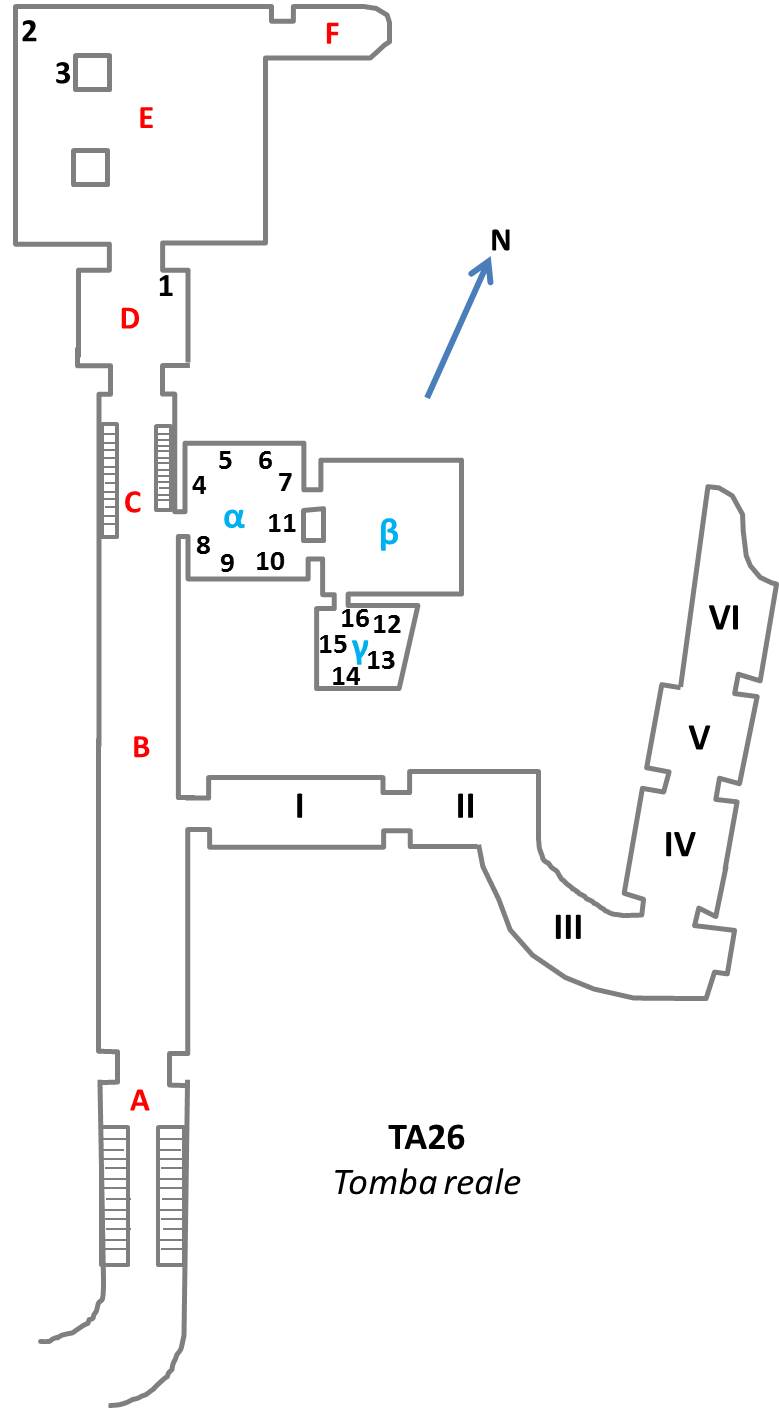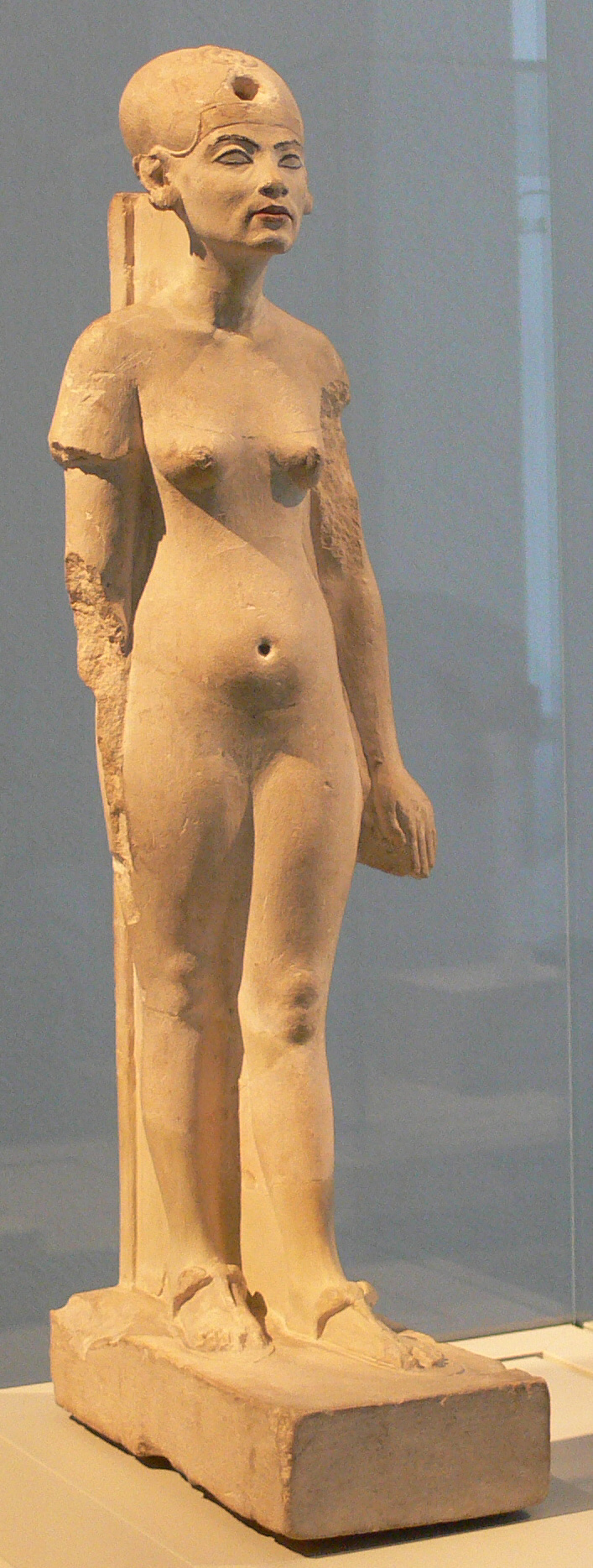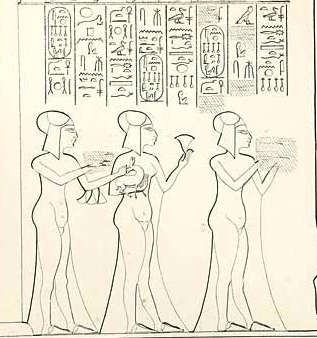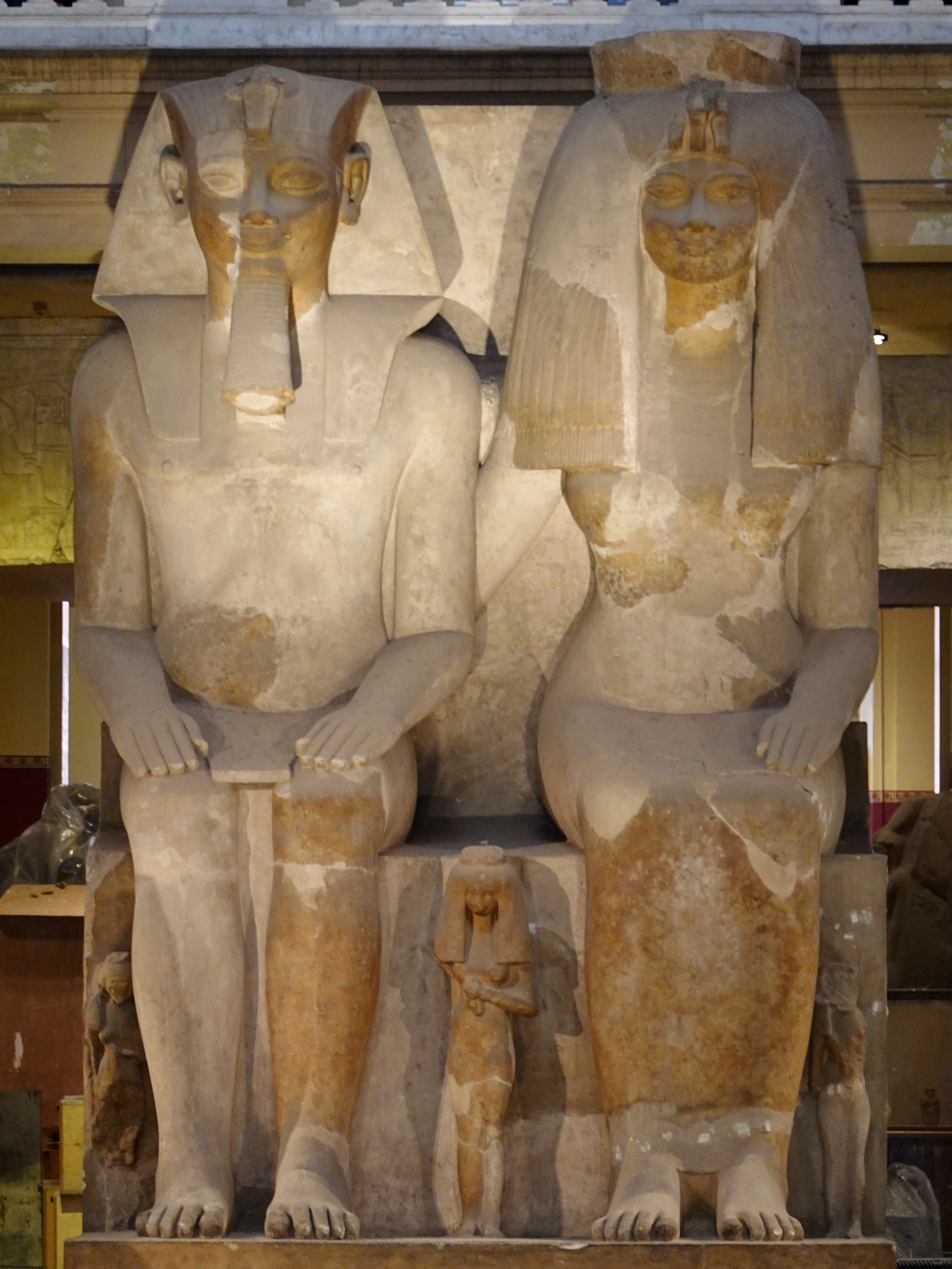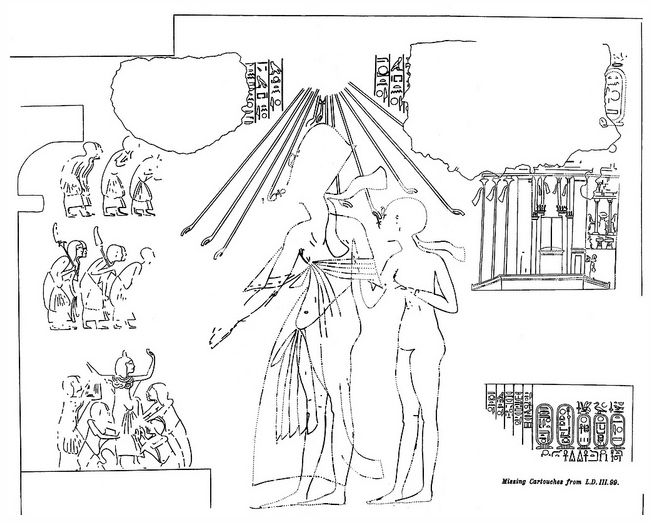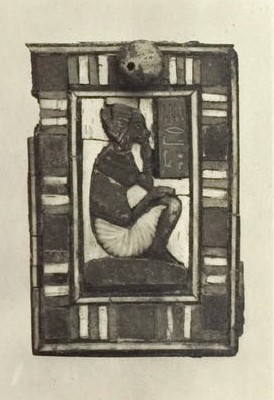|
Meketaten
Meketaten (, meaning "Behold the Aten" or "Protected by Aten") was the second of six daughters born to the Egyptian Pharaoh Akhenaten and his Great Royal Wife Nefertiti. She likely lived between Year 4 and Year 14 of Akhenaten's reign. Although little is known about her, she is frequently depicted with her sisters accompanying her royal parents in the first two-thirds of the Amarna Period. Biography Meketaten was born approximately in Year 4 of Akhenaten's reign to him and his Great Royal Wife, Nefertiti.Tyldesley, Joyce. Nefertiti: Egypt's Sun Queen. Penguin. 1998. She had an elder sister, Meritaten, and four younger sisters: Ankhesenpaaten, Neferneferuaten Tasherit, Neferneferure and Setepenre. Tutankhaten was likely their full brother or half-brother through their father.Dodson, Aidan and Hilton, Dyan. The Complete Royal Families of Ancient Egypt. Thames & Hudson. 2004. Her birth year is estimated based on the dates of inscriptions that reference her. The first known d ... [...More Info...] [...Related Items...] OR: [Wikipedia] [Google] [Baidu] |
Royal Tomb Of Akhenaten
The Royal Tomb of Akhenaten is a multichambered tomb in the Royal Wadi east of Amarna, Egypt, where members of the Amarna Period royal family were originally buried. Akhenaten was an Eighteenth Dynasty pharaoh who reigned for seventeen years (1355-1338 BC) from his capital city of Akhetaten, known today as Amarna. The Royal Tomb was rediscovered in the 1880s; however, the exact year and who discovered it is up for debate. Excavations and research into the tomb began in 1891 and continue to this day. The location of the Royal Tomb, the tomb itself, the artifacts contained within the tomb, and the destruction of parts of the Royal Tomb after Akhenaten's death provide researchers with valuable insights into Akhenaten's reign, including the political environment, and the Amarna Period. Akhenaten's burial chamber can easily be detected in his royal tomb at Amarna since it is the only tomb which was fully finished; the rest of the tomb consists of unfinished rock cut tomb chambers and ... [...More Info...] [...Related Items...] OR: [Wikipedia] [Google] [Baidu] |
Akhenaten
Akhenaten (pronounced ), also spelled Akhenaton or Echnaton ( ''ʾŪḫə-nə-yātəy'', , meaning 'Effective for the Aten'), was an ancient Egyptian pharaoh reigning or 1351–1334 BC, the tenth ruler of the Eighteenth Dynasty of Egypt, Eighteenth Dynasty. Before the fifth year of his reign, he was known as Amenhotep IV (, meaning "Amun is satisfied", Hellenized as ''Amenophis IV''). As a pharaoh, Akhenaten is noted for abandoning traditional ancient Egyptian religion of polytheism and introducing Atenism, or worship centered around Aten. The views of Egyptologists differ as to whether the religious policy was absolutely monotheism, monotheistic, or whether it was monolatristic, religious syncretism, syncretistic, or henotheistic. This culture shift away from traditional religion was reversed after his death. Akhenaten's monuments were dismantled and hidden, his statues were destroyed, and his name Damnatio memoriae, excluded from regnal list, lists of rulers compiled by lat ... [...More Info...] [...Related Items...] OR: [Wikipedia] [Google] [Baidu] |
Nefertiti
Nefertiti () () was a queen of the Eighteenth Dynasty of Egypt, 18th Dynasty of Ancient Egypt, the Great Royal Wife, great royal wife of Pharaoh Akhenaten. Nefertiti and her husband were known for their radical overhaul of state religious policy, in which they promoted the earliest known form of monotheism, Atenism, centered on Aten, the sun disc and its direct connection to the royal household. With her husband, she reigned at what was arguably the wealthiest period of ancient Egyptian history. After her husband's death, some scholars believe that Nefertiti ruled briefly as the female pharaoh known by the throne name, Neferneferuaten and before the ascension of Tutankhamun, although this identification is Neferneferuaten#Nefertiti, a matter of ongoing debate. If Nefertiti did rule as pharaoh, her reign was marked by the fall of Amarna and relocation of the capital back to the traditional city of Thebes, Egypt, Thebes. In the 20th century, Nefertiti was made famous by the disco ... [...More Info...] [...Related Items...] OR: [Wikipedia] [Google] [Baidu] |
Boundary Stelae Of Akhenaten
The Boundary Stelae of Akhenaten are a group of royal monuments in Upper Egypt. They are carved into the cliffs surrounding the area of Akhetaten, or the Horizon of Aten, which demarcates the limits of the site. The Pharaoh Akhenaten commissioned the construction of Akhetaten in year five of his reign during the New Kingdom. It served as a sacred space for the god Aten in an uninhabited location roughly halfway between Memphis and Thebes at today's Tell El-Amarna. The boundary stelae include the foundation decree of Akhetaten along with later additions to the text, which delineate the boundaries and describe the purpose of the site and its founding by the Pharaoh. Total of sixteen stelae have been discovered around the area. According to Barry Kemp, the Pharaoh Akhenaten did not “conceive of Akhetaten as a city, but as a tract of sacred land”. Discovery and publication Sixteen boundary stelae have so far been discovered at Tell El-Amarna. The French Jesuit Claude Sicard w ... [...More Info...] [...Related Items...] OR: [Wikipedia] [Google] [Baidu] |
Neferneferuaten Tasherit
Neferneferuaten Tasherit or Neferneferuaten the younger (, meaning ''most beautiful one of Aten – younger'') (14th century BCE) was an ancient Egyptian princess of the 18th Dynasty and the fourth daughter of Pharaoh Akhenaten and his Great Royal Wife Nefertiti. Family Neferneferuaten was born between c. year 8 and 9 of her father's reign. She was the fourth of six known daughters of the royal couple. It is likely that she was born in Akhetaten, the capital founded by her father. Her name ''Neferneferuaten'' ("Beauty of the Beauties of Aten" or "Most Beautiful One of Aten") is the exact copy of the name Nefertiti took in the 5th regnal year. ("Ta-sherit" simply means "the younger").Tyldesley, Joyce. Nefertiti: Egypt's Sun Queen. Penguin. 1998. She had three older sisters named Meritaten, Meketaten, and Ankhesenpaaten (later known as Ankhesenamun), and two younger sisters named Neferneferure and Setepenre.Dodson, Aidan and Hilton, Dyan. The Complete Royal Families of Ancient ... [...More Info...] [...Related Items...] OR: [Wikipedia] [Google] [Baidu] |
Queen Tiye
Tiye (c. 1398 BC – 1338 BC, also spelled Tye, Taia, Tiy and Tiyi) was the Great Royal Wife of the Egyptian pharaoh Amenhotep III, mother of pharaoh Akhenaten and grandmother of pharaoh Tutankhamun; her parents were Yuya and Thuya. In 2010, DNA analysis confirmed her as the mummy known as "The Elder Lady" found in the tomb of Amenhotep II (KV35) in 1898. Family and early life Tiye's father, Yuya, was a non-royal, wealthy landowner from the Upper Egyptian town of Akhmim, where he served as a priest and superintendent of oxen or commander of the chariotry. Tiye's mother, Thuya, was involved in many religious cults, as her different titles attested (''Singer of Hathor'', ''Chief of the Entertainers'' of both Amun and Min...), which suggests that she was a member of the royal family. Egyptologists have suggested that Tiye's father, Yuya, was of foreign origin due to the features of his mummy and the many different spellings of his name, which might imply it was a non-Egyptian ... [...More Info...] [...Related Items...] OR: [Wikipedia] [Google] [Baidu] |
Tutankhamun
Tutankhamun or Tutankhamen, (; ), was an Egyptian pharaoh who ruled during the late Eighteenth Dynasty of Egypt, Eighteenth Dynasty of ancient Egypt. Born Tutankhaten, he instituted the restoration of the traditional polytheistic form of ancient Egyptian religion, undoing a previous shift to the religion known as Atenism. Tutankhamun's reign is considered one of the greatest restoration periods in ancient Egyptian history. His endowments and restorations of cults were recorded on what is today known as the Restoration Stela. The cult of the god Amun at Thebes, Egypt, Thebes was restored to prominence, and the royal couple changed their names to "Tutankhamun" and "Ankhesenamun", replacing the -aten suffix. He also moved the royal court from Akhenaten's capital, Amarna, back to Memphis, Egypt, Memphis almost immediately on his accession to the kingship. He reestablished diplomatic relations with the Mitanni and carried out military campaigns in Nubia and the Near East. Tutankh ... [...More Info...] [...Related Items...] OR: [Wikipedia] [Google] [Baidu] |
Setepenre (princess)
Setepenre or Sotepenre ( "chosen of Re") was an ancient Egyptian princess of the 18th Dynasty; sixth and last daughter of Pharaoh Akhenaten and his chief queen Nefertiti., p.156 Family Setepenre was born around the 9thTyldesley, Joyce. Nefertiti: Egypt's Sun Queen. Penguin. 1998. to 11th year of her father Akhenaten in the city of Akhetaten.Aldred, Cyril, Akhenaten: King of Egypt ,Thames and Hudson, 1991 (paperback), She had five older sisters named Meritaten, Meketaten, Ankhesenpaaten, Neferneferuaten Tasherit, and Neferneferure.Dodson, Aidan and Hilton, Dyan. The Complete Royal Families of Ancient Egypt. Thames & Hudson. 2004. Life One of the earliest depictions of Setepenre is in a fresco from the King's House in Amarna. She is depicted sitting on her mother Nefertiti's lap. The fresco is much damaged and only a small hand of Setepenre remains. The fresco is dated to ca. year 9 of Akhenaten, and the entire family is depicted. The next time the six princesses appeared to ... [...More Info...] [...Related Items...] OR: [Wikipedia] [Google] [Baidu] |
Meritaten
Meritaten, also spelled Merytaten, Meritaton or Meryetaten () (14th century BC), was an ancient Egyptian royal woman of the Eighteenth Dynasty of Egypt. Her name means "She who is beloved of Aten"; Aten being the sun-deity whom her father, Pharaoh Akhenaten, worshipped. She held several titles, performing official roles for her father and becoming the Great Royal Wife to Pharaoh Smenkhkare, who may have been a brother or son of Akhenaten. Meritaten also may have served as pharaoh in her own right under the name Ankhkheperure Neferneferuaten.J. Tyldesley, ''Chronicle of the Queens of Egypt'', 2006, Thames & Hudson, pg 136–137 Family Meritaten was the first of six daughters born to Pharaoh Akhenaten and his Great Royal Wife, Nefertiti. Her sisters are Meketaten, Ankhesenpaaten, Neferneferuaten Tasherit, Neferneferure, and Setepenre. Meritaten is mentioned in diplomatic letters, by the name ''Mayati''. She is mentioned in a letter from Abimilki of Tyre. The reference usually ... [...More Info...] [...Related Items...] OR: [Wikipedia] [Google] [Baidu] |
Neferneferure
Neferneferure ( "beautiful are the beauties of Re") (14th century BCE) was an ancient Egyptian princess of the 18th Dynasty. She was the fifth of six known daughters of Pharaoh Akhenaten and his Great Royal Wife Nefertiti. Family Neferneferure was born during the 8th or 9th regnal year of her father Akhenaten in the city of Akhetaten.Tyldesley, Joyce. Nefertiti: Egypt's Sun Queen. Penguin. 1998. She had four older sisters named Meritaten, Meketaten, Ankhesenpaaten and Neferneferuaten Tasherit, as well as a younger sister named Setepenre.Dodson, Aidan and Hilton, Dyan. The Complete Royal Families of Ancient Egypt. Thames & Hudson. 2004. Life One of the earliest depictions of Neferneferure is in a fresco from the King's House in Amarna. She is depicted sitting on a pillow with her sister Neferneferuaten Tasherit. The fresco is dated to c. year 9 of Akhenaten, and the entire family is depicted, including the baby Setepenre. Neferneferure is depicted at the Durbar in yea ... [...More Info...] [...Related Items...] OR: [Wikipedia] [Google] [Baidu] |
Kiya
Kiya was one of the wives of the Egyptian Pharaoh Akhenaten. Little is known about her, and her actions and roles are poorly documented in the historical record, in contrast to those of Akhenaten's 'Great royal wife', Nefertiti. Her unusual name suggests that she may originally have been a Mitanni princess.Reeves, C. Nicholas. ''New Light on Kiya from Texts in the British Museum'', p.100 The Journal of Egyptian Archaeology, Vol. 74 (1988) Surviving evidence demonstrates that Kiya was an important figure at Akhenaten's court during the middle years of his reign, when she had a daughter with him.William J. Murnane. ''Texts from the Amarna Period in Egypt.'' Edited by E.S. Meltzer. Atlanta: Society of Biblical Literature, 1995. () Page 9, pp 90–93, pp 210–211.Aidan Dodson. Amarna Sunset: Nefertiti, Tutankhamun, Ay, Horemheb, and the Egyptian Counter Reformation. The American University in Cairo Press, 2009. () Page 17. She disappears from history a few years before her royal hus ... [...More Info...] [...Related Items...] OR: [Wikipedia] [Google] [Baidu] |

